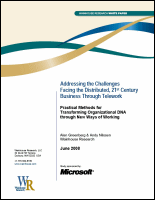Summary
 |
Telework has been around for years as a way to provide flexible work plans for knowledge workers, deal with traffic congestion and business travel, plan for business continuity, and address shortages in office space. For a long time, however, Telework remained somewhat exotic from a policy perspective. Now, Wainhouse Research and others are beginning to identify a fundamental change in attitudes towards Telework and deployment of its supporting technologies. In fact, Telework now has begun to gain currency for most enterprises large and small. The timing of a number of factors – the rising needs of businesses, workers, and community, and the availability of enabling technology – is contributing to an almost perfect storm of conditions that we believe are driving rapid adoption.
To gain fresh insight, in February through April 2008 Wainhouse Research interviewed executives and managers in 22 organizations who use unified communications and collaboration technologies, and another group of human resources and facilities professionals who use these UC technologies. We now believe that, for the first time, Telework is transitioning into being mainstreamed as an accepted practice – along with mobile applications – in enterprises large and small.
In this paper we discuss the business issues that make Telework increasingly attractive to enterprises today, the ways in which Telework is entering the DNA of organizations and solving major issues, the tools necessary to enable the teleworker and other distributed workers, and practical issues to consider from a programmatic perspective. We also explore the future of the teleworking organization through three sample, real-world based scenarios. |
Download File (171.00 KB)